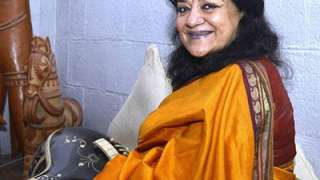MEDIA
Dialogue on distinct styles
www.thehindu.com | November 16, 2017
Rita Ganguly’s ‘Aarohi,’ a three-day festival of Gharana music, delves into its meaning and different characteristics
ita Ganguly’s first encounter with the term ‘gharana’ occurred at the age of two while accompanying her parents to a concert by Ustad Faiyaz Khan, doyen of Agra gharana. She fondly recalls her mischievous behaviour at the concert with a chuckle.
Trained by stalwarts such as Siddheshwari Devi and Begum Akhtar, Ganguly says she sings in the Banaras gharana style with the training of Kirana. Discourses abound on the philosophy or the constitution of a gharana. Rita Ganguly, however, identifies them with certain types of voice production and the unfolding of the raags, which bears the distinct imprint of a gharana. It also represents a set of aesthetic values.
She says, “Gharanas are not about creating clones. Think of Maihar. Each of them was vastly different and a major stylist in his own way. Nikhil Banerjee was so different from Robu da (Pt. Ravi Shankar). Ustad Ali Akbar Khan is a different topic altogether.” To further ideate and have a dialogue about the gharana in Indian classical music, she has conceived ‘Aarohi,’ a three-day festival of Gharana Music.
Organised by Kaladharmi, a non-profit organisation for the promotion of Indian classical arts founded by Rita Ganguly, ‘Aarohi’ is dedicated to Pt. Ravi Shankar and Pt. Bhimsen Joshi, stalwarts of Maihar and Kirana gharanas respectively. Aarohi features an eclectic assemblage of young exponents who will demonstrate the key characteristics of their gharana training and repertoire.
Vocalist Raghunandan Panshikar is one of them. He is fortunate to have trained under both Kishori Amonkar and her mother, Mogubai Kurdikar of the Jaipur-Atrauli gharana. Panshikar’s singing, however, offers glimpses of the influences of many maestros.

He says, “Gharana is the mother tongue. It teaches you discipline and certain behaviour. Kishori ji added ‘bhav’ ang to Jaipur-Atrauli gharana and believed that new elements ought to be added to tradition. The same Raag is rendered in different ways by various singers. It is a reflection of their life, thoughts, and training. Gharana is not a pre-requisite to learn music but if you are specifically talking about Indian classical music, it is impossible to proceed without raagdari. If you know the shastra, you can sing almost anything.”
Musical identity
Sitar player Gaurav Mazumdar equates gharana with his musical identity. He feels it imparts a sense of being but only when you have learnt from a master without any break or lack of continuity, both in learning and practice. Otherwise, it could be dangerous as you are trying to be someone you are not.

Mazumdar’s association with his guru, Pt. Ravi Shankar goes back to November 1985 when he visited Mazumdar’s hometown Allahabad for a concert and heard him play Hindustani Music on the violin. “He accepted me as his disciple. I moved to Delhi to live with him and learnt in the Guru-Shishya parampara. However, after one year, I switched to sitar and began learning the basics from the maestro. He would sing or play and I would reproduce, memorise and practice the material until I had mastered it.
“He was always particular about the time theory, that Raags to be sung and played at a certain time or season and he would take pains of delving into the soul of the raag and teach us all the aspects from alaap, gat to basic sargam or patterns significant to the raag”, Mazumdar reminisces.
Scion of the Gwalior gharana, Meeta Pandit is the sixth of the unbroken Pandit line and also reserves the distinction of being the first woman musician in the family. She feels that, while lineages are to be celebrated for the right reasons, it is an extremely challenging space to be in.

Meeta reasons, “Not only do you face tremendous scrutiny, you are constantly judging yourself on benchmarks that were set in a time and age quite different from ours. Having said that, what I have actually followed is to imbibe the nuances and to apply the technique as per the nature and quality of one’s voice. I have used every bit of the taleem to grow and customis the path for myself.”
Also performing at ‘Aarohi,’ is Bhuvanesh Komkali.

Grandson of Kumar Gandharva, son of Mukul Shivputra, his musical journey began in infancy. His faith in Kumar Gandharva’s musical convictions is unwavering.
Bhuvanesh says, “Kumar Gandharva was never anti-gharana. That’s a myth. He was against ascribing any label to his art. He resisted all attempts at compartmentalising music. Kumar ji was a committed abhyasak of all gharanas which contributed to his catholicity as a musician. You witness a true confluence in his music. That determines his distinct artistic idiom. After all, only those ideas sustain and become part of tradition which has an eternal fragrance.”
Kunal Ray teaches literary and cultural studies at FLAME University and writes on art and culture
(Source: http://www.thehindu.com/entertainment/music/confluence-of-music/article20479537.ece)

